|
Xi'an
Xi'an, capital of Shanxi Province, was called Chang'an in ancient times. It is situated in the central part of Weihe Plain, with the Weihe River flowing in the north and the Qinling Rangs rising and falling in the south. Xi'an records the great changes of the Chinese nation just like a living history book. During Xian's 3,100 year development, 13 dynasties such as Zhou, Qin, Han and Tang placed their capitals here. So far, Xian enjoys equal fame with Athens, Cairo, and Rome as one of the four major ancient civilization capitals. The cultural and historical significance of the area, as well as the abundant relics and sites, help Xian enjoy the laudatory title of "Natural History Museum".
Main tourist attractions include the terra cotta warriors and horses, Great Wild Goose Pagoda, Small Wild Goose Pagoda, Huaqing Pool, BanPo Site, Stele Forest, Mosque, QianLing Mausoleum, Famen Temple and Maoling Mausoleum. Xi'an was the start point of the Old Silk Road that extended from Asia to Europe and played an important role in cultural interflow between the East and West in ancient times.
Recommended Xian Tour:
Recommended China Tours Including Xian:


Tourist Highlights |
| |
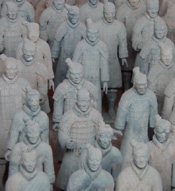 |
Terracotta Warriors and Horses
The Terra Cotta Warriors and Horses are the most significant archeological excavations of the 20th century. Work is ongoing at this site, which is around 1.5 kilometers east of Emperor Qin Shi Huang's Mausoleum, Lintong County, Shaanxi province. It is a sight not to be missed by any visitor to China.
Upon ascending the throne at the age of 13 (in 246 BC), Qin Shi Huang, later the first Emperor of all China, had work begun on his mausoleum. It took 11 years to finish. It is speculated that many buried treasures and sacrificial objects had accompanied the emperor in his after life. A group of peasants uncovered some pottery while digging for a well nearby the royal tomb in 1974. It caught the attention of archeologists immediately. They came to Xian in droves to study and to extend the digs. They had established beyond doubt that these artifacts were associated with the Qin Dynasty (211 --206 BC). |
|
Shaanxi Provincial History Museum
The graceful complex of buildings that constitute the Shaanxi Provincial History Museum in Xi’an’s southern suburbs is built in the style of a Tang Dynasty pavilion, and is in itself worth seeing. The museum’s exhibits, however, are even more breathtaking, consisting of 113,000 artefacts unearthed in the province and chronologically arranged in three exhibition halls. The exhibits cover the Han, Wei, Jin, North and South, Sui, Tang, Song, Yuan, Ming and Quing dynasties, as well as the prehistoric and bronze period.
|
 |
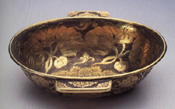 |
|
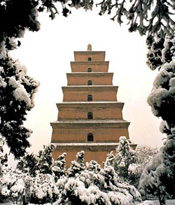 |
Big Wild Goose Pagoda
The Big Goose Pagoda is situated in the Da Ci'en Temple, four kilometers away from the center of the city. It is one of the city's most distinctive and outstanding landmarks, possibly the most beautiful building left in Xi'an today.In AD 652, the Big Goose Pagoda was built to store the sutras and the figurines of Buddha, which were brought from India by a famous Buddhist translator and traveler Tang Sanzang, also known by his Buddhist name as Xuanzang. At the age of 28, he set off to India to study the sutra and then brought back most of the scriptures to Chang'an, present Xian city. Altogether, he spent 17 years for a round trip and experienced many hardships. Upon his return he wrote a book entitled "Journey to the West", recording the customs of different places he visited and his experiences. Subsequently the great novelist of the Ming Dynasty Wu Cheng'en, collected the materials handed down and wrote a novel titled "Pilgrimage to the West" which later became one of four greatest novels in China. As a result, the Television Series about this story was made and became world-renowned. In memory of Xuanzang, his statue is placed in front of the Da Ci'en Temple.
|
|
City Wall
Xian City Wall was constructed in the early Ming Dynasty on the basis of the Imperial City of Chang An (Everlasting Peace) of the Tang Dynasty. It is also a symbol of great significance of the famous historic cultural city of Xian. One of the features of the Xian Wall lies in the fact that it has been preserved intact, which is rarely seen in the world. The construction of the Xian City was formally started in the seventh year of Emperor Hongwu's reign (1374) and completed in the eleventh year of Hongwu's reign (1378). The rectangular city wall is 13.7 kilometers in circumference and has 5,984 crenels and 98 places for the garriosn troops to stay in.
|
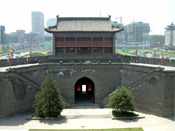 |
|
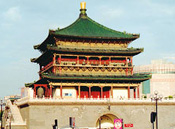 |
The Bell Tower and the Drum Tower
The Bell Tower in Xi'an is situated in the very heart of the city and at the junction of four main roads. The original city Bell Tower was situated to the west of this site and the present construction was built in 1582 and restored in 1739.
There is a huge bell hanging on the roof of the tower which was traditionally used to tell the time by and there are other, smaller bells on exhibit in the tower too.
Today, the Tower can only be accessed form the Subway on Bei Dajie where visitors must also buy their tickets.
To the west of the Bell Tower is the Drum Tower. This is a smaller building, situated in a lively street which is filled with street traders and hawkers. This tower marks the entrance to the city's Muslim Quarter which is a lovely area to wander and observe. the felling here is almost of a "city within a city" and the streets around this district heading up to the Mosque are like a small village crammed with people selling all kinds of weird and wonderful things.
|
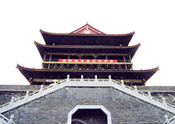 |
|
The Forest of Steles
Steles are huge stone slabs which depict important calligraphic writing, often dating back to ancient times. They are held in high regard in China and many people study the artistry of these mammoth pieces.
The Forest of Steles (Xi'an beilin) is located in the Confucian Temple on Sanxue Jie in Xi'an, this building was first built to preserve the Thirteen Classics of Filial Piety which were engraved during the Tang Dynasty.
A significant collection of Steles was gathered by the Qing dynasty and the building became known as the Forest of Steles.
Today, this is a professional art museum which collects, studies and displays various Steles and stone sculptures. if you are interested in Chinese art and calligraphy, there are some interesting objects on display here. If not, possibly give this one a miss!
|
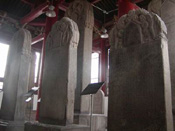 |
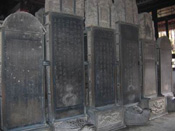 |
|
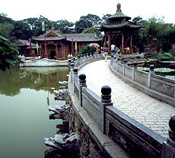 |
Huaqing Pool ( huaqing hot springs )
The Huaqing Hot Springs is located about 35 kilometers east of Xian city at the foot of the Lishan Mountain is a must for every visitor to Xian. For centuries emperors came here to bathe and enjoy the scenic beauty, and it has been a favorite spa since the Tang Dynasty. The Hot Springs Palace was built by Emperor Taizong and a walled palace was added by Emperor Xuanzong in 747 A.D. Unfortunately, it was damaged during the An Lushan Rebellion in the middle Tang period. The present site was rebuilt on the site of the Qing Dynasty structure.
|
|
Banpo Neolithic Village
The Neolithic Village of Banpo is a very nice example of the Yangshao Culture in the Neolithic Age. The remains of this village are located on the eastern bank of the Chanhe River and in the eastern suburb of Xian, about nine kilometers from the center of the city.
These were discovered accidentally in 1953. It is estimated that the village covered an area of 50,000 square meters. 5 excavations between 1953 and 1957 have unearthed about a fifth of the total village (about 10,000 square meters). In 1958 the onsite Banpo Museum was opened |
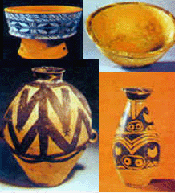 |
|
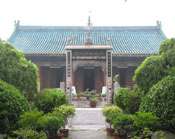 |
Grand Mosque
The Great Mosque in Xian is one of the oldest, largest and best-preserved Islamic mosques in China and its location is northwest of the Drum Tower (Gu Lou) on Huajue Lane.
According to historical records engraved on a stone tablet inside, this mosque was built in 742 during the Tang Dynasty (618-907). This was a result of Islam being introduced into Northwest China by Arab merchants and travelers from Persia and Afghanistan during the mid-7th century when some of them settled down in China and married women of Han Nationality. Their descendants became Muslim of today. The Muslim played an important role in the unifications of China during the Yuan and Ming Dynasties. Hence, other mosques were also built to honor them.
|
|
Recommended Xian Tour:
Recommended China Tours Including Xian:


|
|
| Other City |
|
 |
| Private China Tours |
|
 |
|

